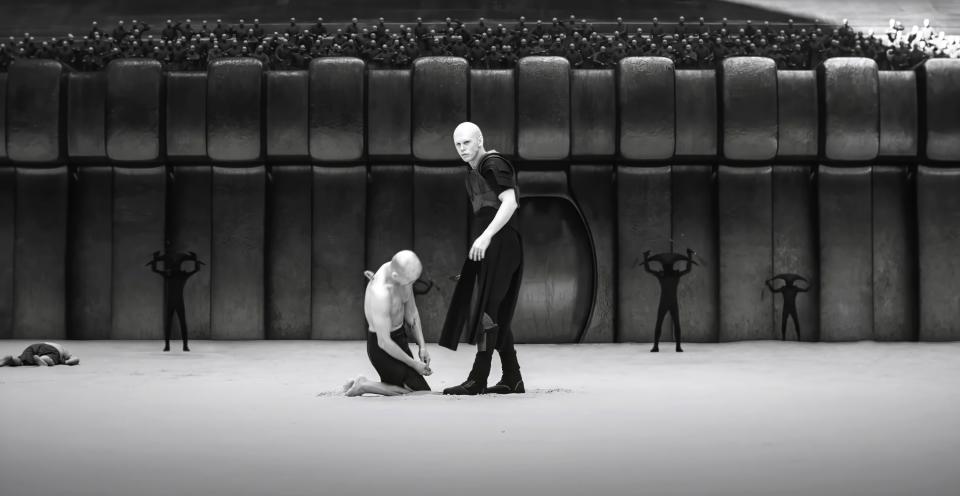Little Time Passed Between ‘Dune’ and ‘Dune: Part Two,’ but Worlds Changed

- Oops!Something went wrong.Please try again later.
- Oops!Something went wrong.Please try again later.
- Oops!Something went wrong.Please try again later.
In narrative time, “Dune: Part Two” starts just three hours after the first “Dune” ends, but the decision to open the film in the middle of an eclipse makes it feel like a completely different world.
During a recent interview for IndieWire’s Filmmaker Toolkit podcast, filmmaker Denis Villeneuve referred to his “idea of the eclipse at the beginning as a tool” to bring an “aesthetic shock” to his sequel. While this choice is motivated by how Paul (Timothée Chalamet) and his mother, Lady Jessica (Rebecca Ferguson), feel out of place in the desert world of the Fremen, it also gave Villeneuve and his team permission to wipe the color palette clean and choose lighting and camera techniques that cinematographer Greig Fraser called “left of center” in the film’s press notes.
More from IndieWire
“I was praying that the gods of cinema [would] allow me to do ‘Part Two’ because I knew with ‘Part One’ I was just like designing the sandbox,” said Villeneuve. “And in ‘Part Two,’ I would have the chance to play with the sand and have cinematic fun.”
According to production designer Patrice Vermette, in the early weeks of audiences embracing “Dune,” Villeneuve started to discuss his vision for “Part Two” with his collaborators, and he specifically expressed his desire to go “more wild.”
“It was like, let’s try to be more psychedelic, and this is where Denis thought about the light,” Vermette told IndieWire. The production designer smiled while remembering the rare combination of a director with studio resources, time to properly world-build, and a mission to get surreal. “I think we could have gone even more wild, but maybe that’s for ‘Part Three.’ If there’s a ‘Part Three,’ there is a messiah,” he said.
That “Part Two” was a financially successful franchise sequel and enjoyed the full-throated marketing support of Hollywood’s next generation of movie stars masks how it’s also among the most expensive and expressionistic art films Hollywood has ever made. While “Part Three” hasn’t been announced, Villeneuve has previously expressed that making a trilogy “would be the dream.”
With the success of the first sequel only putting more wind in the sails of a potential second sequel, looking at what the “Dune” team pulled off in (re)creating the psychedelic world of Giedi Prime in “Part Two” provides some hints as to what could transpire in a possible “Part Three.” The Harkonnen homeworld of Giedi Prime appeared in “Part One,” but for the second film, Villeneuve wanted to push further into how the audience would experience this planet, drained of all natural resources.
“One thing I love in the book is that it’s a study of the impact of the ecosystems on human beings, and I was looking for clues that would give us hints in the Harkonnen psyche. And I thought about the idea that sunlight, instead of revealing color, will subtract colors,” said Villeneuve. “I love the idea that all the laws of physics, or chemistry, can be different on another world. They’re still unknown, outside of our own reality.”
This anti-light, blend-the-laws-of-physics vision spurred cinematographer Fraser to toy with a technique he’d previously applied for visual effects shots. Fraser used an infrared on the camera’s sensor, which cuts visible light, and allows only infrared light in.
The director quickly embraced the results. “It really creates something eerie because you see almost through the skin, and it creates something very specific with the eyes,” said Villeneuve.

For all the current re-emergence of black-and-white cinematography, it’s important to remember that, in the digital age, Hollywood takes comfort in the fact these films are actually shot in color before being desaturated in post, allowing a safety net to revert to color if necessary. This would not be the case with the Giedi Prime scenes.
“I had to warn the studio that there was no way back. It’s not an effect that we did in post-production,” said Villeneuve. “I love the commitment and the risk of it.”
The risk was not just how weird scenes on Giedi Prime would look; the choice altered how color would appear in black and white and not in any consistent pattern. “It was absolutely unpredictable with IR [infrared],” said Villeneuve. Pointing to his clothes, he added, “For instance, this black sweater I’m wearing right now could be white.”
Both light and heat could dramatically change how objects appeared. Cast and extras’ tattoos, which the makeup department is used to covering up, would sometimes show up regardless. Not only would everything put in front of the camera have to be tested — it had to be tested in the exact light and shooting conditions. Villeneuve was not willing to give up control of the image.
Fraser’s truly trippy IR camera is one of the more unconventional and experimental formal choices imaginable in a major studio film, which makes it safe to assume that any “Dune 3” will push the boundaries of the “Dune” world-building even further.
Best of IndieWire
Sign up for Indiewire's Newsletter. For the latest news, follow us on Facebook, Twitter, and Instagram.

